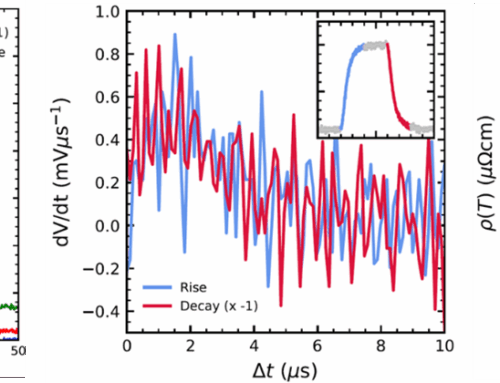C. Shekhar, MPI CPfS Dresden and Y. Skourski, HLD Dresden
In 1929, Hermann Weyl discovered that massless spin-1/2 particles are solutions of the Dirac equation. After many decades, these Weyl particles were finally experimentally revealed in 2015 in simple semimetallic materials such as TaAs. Weyl fermions are low-energy quasiparticle excitations in the vicinity of the unavoidable touching points of a valence band and a conduction band: these materials are “Weyl semimetals”. These touching points always come in pairs with opposite chiralities (right and left) and, moreover, act as large fictitious magnetic fields, so-called Berry fields, for electronic charge carriers. A group of researchers from the Max Planck Institute for Chemical Physics of Solids in Dresden, in collaboration with the Technische Universität Dresden, the high magnetic field laboratories HLD in Dresden and HMFL in Nijmegen, and the PSI Switzerland have performed magneto-transport experiments at low temperatures and high magnetic fields up to 70 T. The observations directly indicate Weyl-fermion-mediated transport properties in GdPtBi and NdPtBi, two members of the Heusler family. The key properties are an extremely large chiral-anomaly effect due to pumping of Weyl fermions between pairs of Weyl points and a large anomalous Hall effect due to a non-zero Berry curvature. The temperature dependence of these two observations follow a similar trend (Figure), thereby revealing their common origin in Weyl fermions. Moreover, this study reveals that there is a crucial role of magnetism in creating Weyl fermions via exchange splitting of bands.

Figure: Evolution of Weyl points (left) evidencing Weyl fermions and measured anomalous Hall effect
and chiral-anomaly effect in GdPtBi (right).
Anomalous Hall effect in Weyl semimetal
half-Heusler compounds RPtBi (R = Gd and
Nd), C. Shekhar, N. Kumar, V. Grinenko, S. Singh, R. Sarkar,
H. Luetkens, S.-C. Wu, Y. Zhang, A. Komarek, E. Kampert,
Y. Skourski, J. Wosnitza, W. Schnelle, A. McCollam,
U. Zeitler, J. Kübler, B. Yan, H.-H. Klauss, S. S. P. Parkin,
C. Felser, PNAS 115, 9140 (2018).







Leave A Comment
You must be logged in to post a comment.